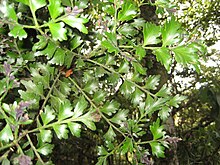Pureora Forest Park
| Pureora Forest Park | |
|---|---|
 Pureora Forest Park | |
| Location | North Island, New Zealand |
| Nearest city | Rotorua |
| Coordinates | 38°37′S 175°32′E / 38.617°S 175.533°E |
| Area | 75,957 hectares (187,690 acres) |
| Established | 1978 |
| Governing body | Department of Conservation |
Pureora Forest Park is a 760-square-kilometre (290 sq mi)[1] protected area in the North Island of New Zealand. Within its rich rainforest are an abundance of 1,000-year-old podocarp trees. It is "recognised as one of the finest rain forests in the world".[2] Established in 1978, after a series of protests and tree sittings, the park is one of the largest intact tracts of native forest in the North Island and has high conservation value due to the variety of plant life and animal habitats. New Zealand's largest totara tree is located nearby on private land.
History
Anti-logging protests were led by conservation activists
Geography
Bounded by the Rangitoto and Hauhungaroa Ranges, Pureora Forest Park is situated between Lake Taupō and Te Kūiti, mostly in Waikato region but some of the park to the south is in the Manawatū-Whanganui region. It is accessible from State Highway 32, which lies to the west of Lake Taupō.[7][8] Peaks include Mount Pureora (1,165 metres (3,822 ft)), and Mount Titiraupenga (1,042 metres (3,419 ft)). To the north west is a peak called Pukeokahu (844 metres (2,769 ft)) that should not be confused with a mountain of the same name much further south in the Rangitikei District of Manawatū-Whanganui region.[9] They are popular among the bike trekkers and also the mountain hikers who use the mountain routes through the park to reach the peaks.
Within the park are Waihora Lagoon and Waihora Stream.[10] The Okahukura Stream is east of Okahukura Road.[9] The Waipa Mires can be seen from Select Loop Road.[11] There are several valleys within the park. These include the Mangakahu Valley, as well as the Tunawaea Valley southeast of Otorohanga.[10] The Maramataha Valley is located in the southwestern part of the park and the nearby Maramataha River is impassable in high water.[12]

A buried,
Fauna and flora
Lower altitudes are characterised by

The
Tourism
Camping, picnicking, swimming, and mountain biking (e.g. the Timber Trail opened in 2013) are popular within the park's confines.[7] And the Pureora Forest Park Hunting Competition has brought hunters to the area since 1987.[20]
There are many areas in the park that are interesting to both tourists and scientists. The Forest Tower is a 12-metre-tall tower located about ten minutes by foot from the Bismarck Road car park. Popular with ornithologists, birds such as kuku, kakariki, and kaka are evident in the area.[3][8][15] The 1978 Treetop Protest Site is still accessible today and includes platforms high in the trees.[15] A 1940s steam hauler, used to transport logs through the forest for milling, and a 2-tonne Caterpillar tractor are still present in the reserve; the latter was used in the 1950s to harvest many totara for posts.[15]
 |
 |
 |
 |
See also
- Forest parks of New Zealand
- Conservation in New Zealand
- Tramping in New Zealand
References
- ^ "Data Table - Protected Areas - LINZ Data Service". Land Information New Zealand. Retrieved 18 October 2017.
- ^ "Walks in the Pureora Forest". Visit Ruapehu. Retrieved 23 November 2022.
- ^ ISBN 978-1-74179-473-1. Retrieved 1 January 2011.
- ^ a b "Our history". nznfrt.org.nz. NZ Native Forests Restoration Trust. Archived from the original on 25 January 2010.
- ^ "Trees crash near totara campers as logging starts". Auckland Star. 19 January 1978.
- ^ a b c d "Pureora Forest Park". sirowaw.net.nz. Retrieved 1 January 2011.[dead link]
- ^ a b c "Mountain biking Pureora". doc.govt.nz. Department of Conservation. Retrieved 1 January 2011.
- ^ a b c "Pureora Forest Park". newzealand.com. New Zealand Tourism Board. Retrieved 23 November 2022.
- ^ a b "Okahukura Loop". Department of Conservation. Retrieved 1 January 2011.
- ^ a b "Pureora mountain biking areas". Department of Conservation. Retrieved 1 January 2011.
- ^ "Select Loop Road". conservation.gen.nz. Retrieved 1 January 2011.
- ^ a b "Waione Tram Mountain Bike Track". Department of Conservation. Retrieved 1 January 2011.
- ^ . Retrieved 1 January 2011.
- ^ a b DeHek, Danny. "Forest Parks – Pureora". newzealandnz.co.nz. Retrieved 1 January 2011.
- ^ a b c d e "Pureora Forest Park" (PDF). Department of Conservation. Retrieved 1 January 2011.
- ^ New Zealand. Dept. of Scientific and Industrial Research (2007). New Zealand journal of zoology. Dept. of Scientific and Industrial Research. p. 183. Retrieved 1 January 2011.
- ISBN 978-4-431-09428-9. Retrieved 1 January 2011.
- ^ "Hunting". conservation.gen.nz. Retrieved 1 January 2011.
- . Retrieved 1 January 2011.
- ^ "Pureora Forest Park Hunting Competition 2010 – a roaring success!". doc.govt.nz. Retrieved 1 January 2011.
External links
- Department of Conservation – Pureora Forest Park
- New Zealand Tramper – Pureora Forest Park
- World Database on Protected Areas – The Pureora Forest Park Conservation Park datasheet

